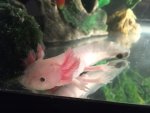Nickelless
New member
I have had my little guy for about a month, and he's around 7 months old. One of his gills has always seemed to be missing filaments on one side, but the breeder didn't mention any medical issues so I thought it was benign. Now today it seems a larger cottony looking growth has appeared I believe is fungus. I'm attaching photos of his gill. Please help, thank you!


